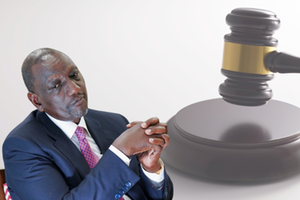Kenya ranked 109 out of 153 countries in gender equality index

From left: Nakuru nominated MCAs Rose Njoroge, Elizabeth Gichuki, Alice Kering, Joyce Anyiso, Doreen Korir, Isabella Makori and Rose Gathoni Njoroge. Kenyan women's political participation is still low. PHOTO | FRANCIS MUREITHI | NATION MEDIA GROUP
What you need to know:
- Kenya scored an index of 0.671 out of possible 10 marks.
- Rwanda topped the Sub-Saharan list with an index of 0.791.
- Iceland remains the world’s most gender-equal country for the 11th year running with an index of 0.877.
- Namibia, which was ranked number 12 globally, was second in Africa with an index of 0.784.
Kenya has once again missed in the list of top 10 Sub-Saharan African countries promoting gender equity according to the Global Gender Gap Index ranking 2020.
According to the findings of the World Economic Forum’s Global Gender Gap Report 2020, Kenya is ranked 109 out of the 153 countries that were rated on their progress towards gender parity in 2019. At least 34 countries were surveyed in Sub-Saharan Africa. Kenya scored an index of 0.671 out of possible 10 marks.
Gender parity
Now in its 14th year, the Global Gender Gap Report benchmarks countries' progress towards gender parity in areas such as economic participation and opportunity, education, health and political empowerment.
Political participation for Kenyan women is still yet to meet the constitutional provision. The country is yet to attain the two thirds threshold for gender political representation.
Currently, out of the 349 MPs in the National Assembly, only 76 legislators are female.
According to the Constitution, the National Assembly should have at least 117 female MPs. The House still has a deficit of 41 female legislators as required by law.
The Senate is not doing any better either. It has 21 female senators instead of the required 23.
Heading boards
According to a 2017 report by the Kenya Institute of Management, the number of women heading boards still remains low at just five among listed firms.
This year’s report examines gender gap prospects in areas such as data, engineering, content production and sales and marketing among others.
Rwanda topped the Sub-Saharan list with an index of 0.791. At number nine globally, it was the only country in Africa in the top 10.
Iceland remains the world’s most gender-equal country for the 11th year running with an index of 0.877 followed by Norway (0.842), Finland (0.832), Sweden (0.820) and Nicaragua (0.804).
Namibia, which was ranked number 12 globally, was second in Africa with an index of 0.784. South Africa, which was ranked 17th globally, came third with an index of 0.780.
Burundi, which was ranked 32nd globally, was fourth in Africa with 0.744, while Zambia, which was ranked 45th globally, was fifth in Africa with an index of 0.731.
Zimbabwe was number six in Africa and 47 in the world ranking. It had had an index of 0.730. Ranked 52nd globally, Cape Verde came seventh in Africa with an index of 0.725, followed by Mozambique who were ranked number 56 in the world with an index of 0.723.
Madagascar came ninth in Africa and 62nd globally with an index of 0.719. Uganda which was ranked number 65 globally, completed the top 10 list in Sub-Saharan Africa with an index of 0.717.
Political empowerment
The most improved country in Sub-Saharan Africa was Ethiopia which was ranked 13th in Africa and number 82 globally with an index of 0.705.
Ethiopia’s remarkable adjustment in global rankings was largely driven by improvement in the political empowerment.
According to the current trajectory for closing gender gap, the overall global gender gap will close in 100 years. It will register a marked improvement on the 108 years in the 2018 index.
The attainment of gender parity in education globally is expected to take just 12 years. So far, a total 35 countries have achieved gender parity in education.
In healthcare, 48 countries have achieved near-parity, while 71 have closed at least 97 per cent of the gap.
“Education attainment as well as health survival enjoy much closer to parity at 96.1 per cent and 95.7 per cent respectively,” says the report.
Gender parity has been fully achieved in 40 of the 153 countries ranked.
Gender gap
Globally, gender parity stands at 68.6 per cent and the bottom 10 countries have closed just 40 per cent of the gender gap.
The report reveals that improvement in political representation helped narrow the overall global gender gap, even though prospects for economic opportunities have dropped in the past 12 months.
“Overall the political arena remains the worst performing dimension,” says the report findings that were made public on December 17, 2019.
The report states that it will take 95 years to close gender gap in political representation, with women in 2019 holding 25.2 per cent of parliamentary seats and 21.2 per cent of ministerial positions.
In the past 50 years, 85 countries have had no female heads of state.
The report raises concern in the economic opportunities for women. The deteriorating situation has forced gender parity to 57.8 percent.
“This represents a massive 257 years before gender parity can be achieved,” says the report.
Obtaining credit
The report cites lack of access to capital as one of the reasons widening the gender gap. The economic decline for women is attributed to not enough women entering professions where wage growth is pronounced. There are 72 countries where women are barred from opening bank accounts or obtaining credit.
Globally, only 55 per cent of women (aged 15-64) are engaged in the labour market as opposed to 78 per cent of men.




